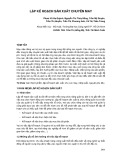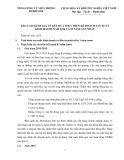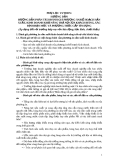
ISSN 1859-1531 - THE UNIVERSITY OF DANANG - JOURNAL OF SCIENCE AND TECHNOLOGY, VOL. 22, NO. 12, 2024 7
AN INNOVATIVE GENETIC ALGORITHM-BASED MASTER SCHEDULE TO
OPTIMIZE JOB SHOP SCHEDULING PROBLEM
Thi Phuong Quyen Nguyen*, Thi Hoa Thuong Le
The University of Danang - University of Science and Technology, Vietnam
*Corresponding author: ntpquyen@dut.udn.vn
(Received: September 27, 2024; Revised: October 29, 2024; Accepted: November 01, 2024)
DOI: 10.31130/ud-jst.2024.422E
Abstract - The rapid development of manufacturing sectors in the
contemporary Industry 4.0 era has prompted enterprises to adopt
increasingly systematic, streamlined, and efficient organizational
structures. In this scenario, production scheduling has arisen as an
essential function that contributes to the effective allocation of
organizational resources in the production process, while
shortening production time and satisfying customer deadlines.
Consequently, the objective of this study is to develop an advanced
method to optimize the production scheduling problem.
Accordingly, this study proposes an innovative genetic algorithm-
based master schedule (GA-MS) focused on minimizing makespan.
The proposed method is implemented in various benchmark
datasets on job shop scheduling problems. Compared with some
benchmark methods such as priority rules-based approaches,
branch and bound algorithm (B&B), and shifting bottleneck
algorithm (SB), the proposed GA-MS shows an outstanding
performance concerning the tested datasets. Its application in
practical manufacturing factories is highly recommended.
Key words – Job shop scheduling problem; genetic algorithm;
master schedule.
1. Introduction
In today's competitive environment, production
scheduling plays a very important role in the sustainability
of enterprises within the marketplace. To fulfill customer
demands, such as timely delivery, organizations must
develop a precise strategy, adeptly allocate, and utilize
available resources effectively and reasonably. If a firm
underestimates the importance of production scheduling, it
may face many difficulties in its operations, resulting in
resource inefficiency, reduced productivity, and substantial
cost increases [1].
There are many types of production scheduling models
such as single machine scheduling model, flow shop, job
shop scheduling model, open shop, and so on. However,
the job shop scheduling problem (JSSP) is the most popular
one in practical issues. JSSP is a production or service
model in which each job has a separate route through
different machines or equipment. In the JSSP model, there
is always a conflict over resources such as human resources
and equipment. Thus, JSSP is a difficult problem among
all types of scheduling problems [2].
The JSSP in manufacturing industries is characterized
by multifunctional machinery and equipment that produces
multiple products with a wide range of features processed
on a variety of machines, each of which can process a large
number of details [3]. For example, printed circuit boards
in the semiconductor industry are often produced in the
form of job shops; orders are usually a certain batch of
products, carried out through a given route with specific
execution times.
The JSSP is classified as the NP-hard (Non-
Polynominal-hard) problem and cannot be solved like
normal linear programming problems [4]. Various meta-
heuristics approaches have been proposed to solve JSSP,
such as genetic algorithms (GA) [5, 6], evolutionary
algorithms [7, 8], ant colony optimization [9], and particle
swarm optimization (PSO) [10]. Among these meta-
heuristics approaches, GA is the most popular one for
solving optimization problems [11].
Thus, this study proposes an innovative genetic
algorithm-based master schedule (denoted as GA-MS) to
optimize the JSSP. A master schedule (MS) is a matrix that
shows the sequence of jobs processed in each machine.
Each MS is coded as a chromosome. An innovative method
is developed to generate numerous MS for the initialization
of GA procedure in which each MS can avoid infeasible
solutions due to the job’s sequence constraint. Thereafter,
the genetic operation is implemented to determine the
optimal solution to minimize makespan for JSSP.
2. Related works
2.1. Overview of JSSP
Table 1. Notations of JSSP
n
Number of jobs
m
Number of machines
i
Index of machines, i=1, 2,…, m
j
Index of jobs, j=1, 2,…, n
pij
Processing time of job j on machine i
xij
Starting time of job j on machine i
rj
Release date/ Ready date of job j
dj
Due date of job j
Cj
Completion time of job j
𝐶𝑚𝑎𝑥
Make-span 𝐶𝑚𝑎𝑥= max{Cj: j = 1, 2, …, n}
Fj
Flow time job j
Lj
Lateness (Lj = Cj – dj)
Tj
Tardiness Tj = max (0, Lj).
The classical JSSP is identified in manufacturing in
which n different jobs/products are to be scheduled on m
different machines, subject to two main sets of constraints
which are the precedence constraints and the conflict
constraints. Each job has a different sequential operation.
The processing time of each job on machines is known,
consistent, and independent of the schedules on machines.

8 Thi Phuong Quyen Nguyen, Thi Hoa Thuong Le
The objective of JSP is to sequence jobs on machines and
specify the starting time and ending time of each job to
minimize certain performance. In this case, the objective
function is to minimize makespan. Some notations of JSSP
are listed in Table 1.
The problem can be modeled as follows:
Objective function
Min 𝐶𝑚𝑎𝑥 (1)
S.t.
∑𝑌𝑖𝑗𝑗′= 1
𝑛
𝑗′=1
𝑗′≠𝑗
(2)
∑𝑌𝑖𝑗𝑗′= 1
𝑛
𝑗=1
𝑗≠𝑗′
(3)
xij+ pij ≤ xi’j (4)
xij+ pij ≤ xij’ + M(1 − Yijj’) (5)
xij’+ pij’ ≤ xij + MYijj’ (6)
xij≥ rj≥ 0 (7)
Cj = xlj + plj (8)
Eq. (1) is used for the objective function that is
minimizing make-span 𝐶𝑚𝑎𝑥= max{Cj: j = 1, 2, …, n}.
Eq. (2) indicates that on each machine i, when a job
completes its processing, only one job in the set of
available jobs is selected for processing. Eq. (3) means an
operation of a job should follow only one processor. Eq.
(4) is used for the precedence constraints. The precedence
constraints ensure that each operation of a certain job is
processed sequentially. Eq. (5) and (6) present the conflict
constraints where M is a constant that is assumed to be a
big number. The conflict constraints guarantee that each
machine processes only one job at a time. Eq. (7) is to make
certain that any job cannot start before its ready time. Eq.
(8) is a formulation to identify the completion time of each
job on each machine. Variable “l” in Eq. (8) is the last
machine that product j is processed on. Eq. (9) explains the
binary variable 𝑌
𝑖𝑗𝑗’. 𝑌
𝑖𝑗𝑗’ = 1 if job j is produced before job
j’ on machine i. Unless, 𝑌
𝑖𝑗𝑗’ will get a value of 0.
2.2. Priority rules-based methods for scheduling problems
This section introduces some methods to solve the
scheduling problems based on the priority rules. A priority
rule is a type of policy that determines a specific
sequencing choice for each time a machine idles. A priority
rule is a type of policy that determines a specific
sequencing choice for each time a machine idles [12].
Some priority rule-based methods can be listed as follows:
(1) Earliest Due Date (EDD): The job with the earliest
due date is selected to be executed first in which the goal
is to minimize maximum lateness.
(2) Longest Processing Time (LPT): the sequence of
jobs depends on its processing time. The job with the
largest processing time will be scheduled first. This rule is
usually applied in parallel machine models to balance the
workload across machines.
(3) Weight Shortest Processing Time (WSPT): The job
with the largest ratio (wj/pj) is done first. This rule aims to
minimize the total weighted completion time ∑𝑤𝑗𝐶𝑗. When
all weights are equal, the WSPT rule becomes the SPT rule.
(4) Minimum Slack (MS): When a machine is idle at
time t, the remaining slack time of each job at that time t is
defined as:
Slack = (dj – pj – t) (10)
Slack will be negative for late jobs, zero for on-time
jobs, and positive for early jobs.
(5) Shortest Set-up Time (SST): This rule selects the job
that has the smallest set-up time to implement first.
(6) Least Flexible Job (LFJ): This rule selects the job
with the least flexibility to process (the least flexible job
can only be executed on a certain number of machines or
processed by the fewest number of machines). This rule is
suitable for the heterogeneous parallel machine model.
(7) Critical Path (CP): Select the job on the critical
path to perform first, suitable for jobs with precedence
constraints.
(8) Largest Number of Successors (LNS): Choose the
job with the longest list of following jobs to do first.
2.3. Heuristic methods for JSSP
Branch and Bound (B&B): The B&B [13] constitutes
an enumeration technique whereby all conceivable job
sequences are cataloged within a hierarchical structure.
Subsequently, the array of scheduling tables is sequentially
eliminated by demonstrating that the target values
associated with all schedules exceed a predetermined lower
bound. This lower bound is defined as being greater than
or equal to the target value of a previously attained
schedule. The B&B is extensively employed to ascertain
an optimal solution to the scheduling problem.
Nonetheless, it is characterized by significant time
consumption, as the number of nodes is often very large.
Genetic Algorithm (GA): GA [5, 6] aims to develop
solutions that outperform their parents by utilizing diverse
methodologies. GA begins with the initialization step, which
simultaneously creates a population with many solutions.
The best solutions are then selected from the generated
alternatives. Thereafter, genetic operators, including
crossover and mutation processes, are used for these selected
individuals to generate offspring under the principle of an
evolutionary process, i.e., the next generation is always
better than the previous generation. This iterative procedure
persists until an optimal solution is attained.
Particle Swarm Optimization Algorithm (PSO): PSO
[10] is an algorithm designed to address optimization
problems on an intelligent population model or intelligent
swarm. PSO is a straightforward but efficient technique for
optimizing continuous nonlinear objective functions. It has
been effectively applied to solve numerous function
extremum problems as well as multi-objective problems.
This study uses GA-based MS to optimize the JSSP. GA is
selected among other heuristic methods due to its effectiveness
has been proven in many optimization problems [5, 6].
Yijj’ =
0 otherwise
1 if job j is before job j’ on machine i
(9)

ISSN 1859-1531 - THE UNIVERSITY OF DANANG - JOURNAL OF SCIENCE AND TECHNOLOGY, VOL. 22, NO. 12, 2024 9
3. Proposed GA-MS for JSSP
The idea for the proposed GA-MS to solve the JSSP is
developed based on the MS. Each MS is a solution for the
JSSP, i.e., a sequence of jobs to be processed on machines.
The procedure of the proposed GA-MS begins with the
initialization process based on designing and generating the
MS. Then, the proposed GA-MS will follow the general
procedure of genetic operation until obtain optimal solution.
The details will be presented in the following subsections.
3.1. Master Schedule
MS is a combination of schedules for each job/product
on each machine in the production process. Note that the
processing time is known, consistent, and independent of
the schedules on machines. Therefore, the result of the
JSSP is to know the schedules for jobs/products on all
machines, which is called the MS. However, each product
has to follow its processing sequence which is known as
precedence constraint. Thus, it is necessary to consider
how one machine's schedule will affect the schedules of the
remaining machines when generating a feasible MS.
An example is given to illustrate how to generate an
MS. Given a JSSP with 3 jobs and 2 machines, the
sequence of performing each job on the machines is shown
in Table 2. The number in a row in Table 1 represents the
order of machines that process jobs. For instance, Job 1 (J1)
is processed on M1 first, then goes to M2. The sequence of
Job 2 (J2) is on M2 first then moves to M1.
Table 2. Sequence matrix in JSSP
Sequence
Machine
M1
M2
Job
J1
1
2
J2
2
1
J3
1
2
The processing time of a job on one machine is shown
in Table 3. It is identified based on the job row and machine
column. For instance, the processing time of J1 on M1 is
14; the processing time of J2 on M1 is 6.
Table 3. Sequence matrix in JSSP
Processing Time
Machine
M1
M2
Job
J1
14
16
J2
6
4
J3
2
8
Table 4 illustrates an MS. In the MS matrix, the
schedule on one machine is represented in an equivalent
column of the machine. For instance, the sequence of jobs
processed on machine M1 is J2-J1-J3, and on machine M2
is J1-J2-J3.
Table 4. An illustration of an MS
Master Schedule
Machine
M1
M2
Job
J1
2
1
J2
1
2
J3
3
3
Referencing the MS in Table 3, the solution is infeasible
because the schedule conflicts with the processing sequence
in Table 1. For instance, M1 cannot process J2 first since it
has to wait for the completion of J2 on M2. However,
according to the MS, J2 cannot be processed on M2 because
M2 has to process J1 first. Similarly, J1 cannot be processed
on M2 due to the processing sequence and J1 needs to go to
M1 first. As a result, the schedule is blocked.
Thus, this study develops a method to generate an MS
that can avoid infeasible solutions. The concept to generate
the feasible MS is to select one machine as the “Main
Machine”. Schedules on other machines are based on the
schedule on the Main Machine and the sequence matrix.
For the above example, suppose that we select M1 as
the Main Machine, and assign the schedule on M1 as Table
4. Then, we will generate the schedule on M2 as follows:
Step 1: Consider the column M2 of the sequence
matrix, only J2 is available to be processed in M2, hence
assign J2 to M2. The result is illustrated in Table 5.
Table 5. An illustration to generate a feasible MS
Sequence
Machine
Master
Schedule
Machine
M1
M2
M1
M2
Job
J1
1
2
Job
J1
2
J2
2
1
J2
1
1
J3
1
2
J3
3
Step 2: Due to Step 1, J2 is assigned to be the first in
M2; hence J2 can be processed on M2, then on M1. When
M1 completes J2, it will continue with J1 without violating
the J1 processing sequence. After J1 is completed, J3 is
processed on M1 as scheduled on M1 is J2-J1-J3. The
current schedule is presented in Table 6. In the sequence
matrix, “0” means already finished jobs while “1” means
available jobs to be processed.
Table 6. An illustration to generate a feasible MS
Sequence
Machine
Master
Schedule
Machine
M1
M2
M1
M2
Job
J1
0
1
Job
J1
2
J2
0
0
J2
1
1
J3
0
1
J3
3
Step 3: Both J1 and J3 are available, we assign them in
M2 based on the available time rule, which is the sooner
the product is available, the higher the probability to be
assigned before the others. This rule can enhance the
diversity of solutions to large-scale problems. The
schedule shown in Table 7 is a feasible MS.
Table 7. An illustration to generate a feasible MS
Sequence
Machine
Master
Schedule
Machine
M1
M2
M1
M2
Job
J1
0
1
Job
J1
2
2
J2
0
0
J2
1
1
J3
0
1
J3
3
3
3.2. Proposed GA-based MS
3.2.1. Chromosome representation
A chromosome is coded as a feasible MS. According to
Section 3.1, a feasible MS is a matrix type where the

10 Thi Phuong Quyen Nguyen, Thi Hoa Thuong Le
schedule on each machine is shown in the path
representation. For instance, the sequence in M1 in Table
7 is J2→ J1→ J3. Because of precedence constraints, each
job will follow its processing sequence. It leads to the
schedules in the path representations that have different
length sizes. Table 8 illustrates this case.
Table 8. An MS with different length sizes in each machine
Machine
Job
M1
J1
J3
J4
J2
M2
J4
J2
J3
M3
J2
J3
J1
J4
Thus, a feasible MS should be coded in the matrix
representation with the length consistently. From Table 8,
an MS with the same is transformed and shown in Table 9.
The number in Table 9 shows the order of jobs that are
processed in each machine. For instance, J1 is processed in
M1 first, thus the cell M1J1=1. J1 does not go to M2, so
the cell M2J1=0. Similarly, J1 is executed in M1 in the 3rd
order. Thus, the cell M3J1 gets a value of 3. This way is
used to transform all jobs in Table 8 to Table 9.
Table 9. An MS in the matrix representation
Machine
Job
J1
J2
J3
J4
M1
1
4
2
3
M2
0
2
3
4
M3
3
1
2
4
3.2.2. Initialization
Each MS represents a chromosome. To generate a
population-based MS, the study designs to code a number
that is equivalent to a schedule on each machine. Following
the process to generate an MS, after choosing a Main
Machine, the sequence of jobs processed on the Main
Machine is determined. The number of possible schedules
also has to be defined on the Main Machine. For example,
if we have a job list including n jobs that will be processed
on the Main Machine; it means we will have n factorial
permutation schedules of n jobs. Each possible schedule is
equivalent to one unique value. Based on the population
situation of each iteration, each individual (chromosome)
is represented by one value. Converting the value of an
individual into one unique schedule on the Main Machine
will be followed in these steps.
Step 1
Order the job list including n jobs
Pick up Value
Calculate Order = roundup (Value/(n-1)!)
Select a job on the list as the first order at machine.
Step 2
Update Job List: (n-1) jobs
Order the remaining job list
Calculate Update Value = previous Value - (n-1)!
*(previous Order-1)
Calculate Update Order = roundup (Update
Value/((n-1)-1)!)
Select a job on the list as the second order at machine
Step 3: Repeat step 2 until the final job on the list
Table 10 shows the possible schedule of 4 jobs on the
Main Machine. The schedules of these jobs in other
machines are determined based on the process of
generating an MS. Then, all possible MSs are used for the
initial population.
Table 10. Schedule on Main Machine with n=4
Value
Schedule
Value
Schedule
1
1 – 2 – 3 – 4
13
3 – 1 – 2 – 4
2
1 – 2 – 4 – 3
14
3 – 1 – 4 – 2
3
1 – 3 – 2 – 4
15
3 – 2 – 1 – 4
4
1 – 3 – 4 – 2
16
3 – 2 – 4 – 1
5
1 – 4 – 2 – 3
17
3 – 4 – 1 – 2
6
1 – 4 – 3 – 2
18
3 – 4 – 2 – 1
7
2 – 1 – 3 – 4
19
4 – 1 – 2 – 3
8
2 – 1 – 4 – 3
20
4 – 1 – 3 – 2
9
2 – 3 – 1 – 4
21
4 – 2 – 1 – 3
10
2 – 3 – 4 – 1
22
4 – 2 – 3 – 1
11
2 – 4 – 1 – 3
23
4 – 3 – 1 – 2
12
2 – 4 – 3 – 1
24
4 – 3 – 2 – 1
3.2.3. Evaluation of Fitness Value
The study considers minimizing the value of makespan.
Makespan is the total time required to complete a set of
jobs from the beginning of the first job to the end of the
final job.
Make-span 𝐶𝑚𝑎𝑥= max{Cj: j = 1, 2, …,n} (10)
3.2.4. Genetic operation
The genetic operation includes the selection, crossover,
and mutation process. The proposed GA-MS employs the
Roulette Wheel method for the selection process to choose
the parent chromosomes for producing the next generation.
Regarding the crossover process, the traditional one-point
crossover is utilized in which a random position in two
selected chromosomes is picked up to perform crossover.
Similarly, the mutation process is performed on a schedule
of the Main Machine by randomly selecting two jobs and
swapping two jobs at selected locations.
The offspring are produced after the genetic operation.
The process is repeated to evaluate the fitness values of the
offspring and continue with the genetic operation to
reproduce the next generation. This process is repeated
until the stopping criteria are met.
Some advances are designed in the proposed GA-MS.
First, parameters are adjusted to encourage diversity during
early iterations, thereby enhancing the exploration of the
global optimum. Additionally, to improve exploitation to
the local optimum, 10% of the population is replaced by
very good solutions when the total number of iterations
exceeds 90% or the best solution consistently persists for
40% of the total iterations. This strategy enables the
population to conduct a dense search for the very best
answers. To cut down on running time, the program is
designed to self-terminate if the optimal solution remains
unchanged after 50% of the total iterations.

ISSN 1859-1531 - THE UNIVERSITY OF DANANG - JOURNAL OF SCIENCE AND TECHNOLOGY, VOL. 22, NO. 12, 2024 11
4. Experimental Result
4.1. Parameter setting
To implement the proposed GA-MS, some parameters
need to be set up such as the number of iterations (ItNum),
population size (Popsize), probability of crossover:
(Prob_CO), probability of Mutation (Prob_Mut). The
values of ItNum and Popsize are chosen according to the
experimental results of some previous research. The
crossover rate Prob_CO is from 0.8 to 1.0. A high
crossover rate is selected to lead to premature convergence.
The mutation rate Prob_Mut is usually from 0.005 to 0.1.
In this case, the high mutation rate is selected to enhance
diversity. Finally, we experiment with multi-trials and
determine the parameter for the proposed GA-MS as
follows: ItNum = 200, Popsize = 100, Prob_CO = 0.8, and
Prob_Mut = 0.1
4.2. Dataset
Ten tested datasets collected from OR-Library
(http://people.brunel.ac.uk/~mastjjb/jeb/orlib/jobshopinfo.
html) are employed to implement and evaluate the
performance of the proposed GA-MS. These datasets are
usually used as the benchmarks for JSSP. The tested
datasets can be classified into three types: 1) small-scale
problems with n, m 4; 2) medium-scale problems with
4 < 𝑛, 𝑚 10; 3) large-scale problems with 𝑛, 𝑚 > 10.
There are three small-scale datasets, four medium-scale
datasets, and three large-scale datasets.
4.3. Result analysis
To evaluate the effectiveness of the proposed GA-MS,
some benchmark algorithms are also used to compare its
performance. This study selects the EDD rule since it is the
most popular one among other priority rule-based methods.
Besides, B&B and shifting bottleneck (SB) methods are
also chosen as benchmark algorithms due to their simple
but straightforward and efficient in solving JSSP.
Table 11. The experimental result
Dataset
EDD
B&B
SB
GA-MS
1
32
28
28
29
2
35
32
31
26
3
38
33
33
30
4
461
262
262
273
5
215
138
150
131
6
142
110
118
104
7
837
790
798
736
8
1286
1022
1022
983
9
1854
1682
1676
1392
10
2717
2523
2598
2152
The proposed GA-MS is implemented 20 times on each
tested dataset and its average result is obtained. Table 11
shows the results of the proposed GA-MS with the three
benchmark algorithms. The value in Table 11 is the
makespan in which the smaller makespan is the better
algorithm. The makespan was computed for each method
based on Eq. (10) with its notation presented in Table 1.
The result in Table 11 exhibits that the best makespan
values vary based on the scale of problems. For small-scale
problems, which are shown by the result of datasets 1 to 3,
it is obvious that the GA-MS outperforms the other
benchmarks since it achieves two best makespans on
datasets 2 and 3. The B&B and SB algorithms rank the
second order with the best makespan on dataset 1. EDD
cannot obtain any best makespan on small-scale datasets.
However, there is not a big difference between these
algorithms in terms of makespan in these datasets. For
example, the best makespan of dataset 2 provided by GA-
MS algorithms is 26 while the worst makespan obtained by
EDD is 35. The gap in makespan between GA-MS and
B&B is also small with only 6.
Figure 1. The comparison results on different datasets
Regarding the medium-scale problems from datasets
4 to 7, the proposed GA-MS is still the best one since it
obtains the best performance on 3 datasets. Especially,
the difference in makespan between the proposed GA-MS
and EDD method is relatively large. This illustrates the
effectiveness of the proposed GA-MS when the scale of
problems increases. The result is similar to the large-scale
problems shown in datasets 8 to 10. It is noted that as
problem sizes rise, the makespan gaps between the
suggested GA-MS and B&B and GA-MS and SB also
widen. Generally, heuristic methods such as EDD, B&B,
and SB are ineffective for large and complicated
problems. The proposed GA-MS can find the optimal
solutions for these JSSPs quickly and efficiently. The
computational time to implement the proposed GA-MS is
also promising. It only takes from few seconds for the
small-scale dataset to less than 5 minutes for the large-


![Lập kế hoạch sản xuất giai đoạn hoàn tất sản phẩm [chi tiết]](https://cdn.tailieu.vn/images/document/thumbnail/2021/20211031/vibigates/135x160/7681635684163.jpg)










![Tối ưu hóa hiệu suất hệ thống: Bài thuyết trình [Chuẩn nhất]](https://cdn.tailieu.vn/images/document/thumbnail/2025/20251107/hiepdz2703@gmail.com/135x160/35941762488193.jpg)




![Bài giảng Quản trị chất lượng trong công nghiệp thực phẩm [chuẩn nhất]](https://cdn.tailieu.vn/images/document/thumbnail/2025/20250805/vijiraiya/135x160/637_bai-giang-quan-tri-chat-luong-trong-cong-nghiep-thuc-pham.jpg)

![Đề cương bài giảng Kỹ năng hoạt động công nghiệp [mới nhất]](https://cdn.tailieu.vn/images/document/thumbnail/2025/20250715/kimphuong1001/135x160/76971752564028.jpg)


![Bài giảng Kỹ thuật điều độ trong sản xuất và dịch vụ [mới nhất]](https://cdn.tailieu.vn/images/document/thumbnail/2025/20250630/dcbaor/135x160/13121751251866.jpg)


